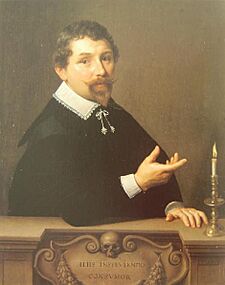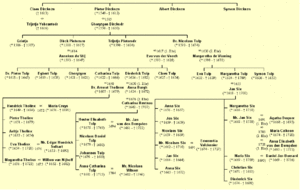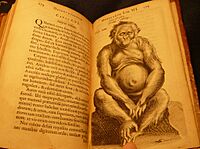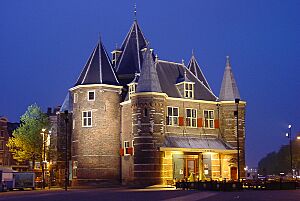Nicolaes Tulp facts for kids
Quick facts for kids
Nicolaes Tulp
|
|
|---|---|

Nicolaes Tulp by Nicolaes Eliasz. Pickenoy (1633).
|
|
| Born |
Claes Pieterszoon
9 October 1593 |
| Died | 12 September 1674 (aged 80) |
| Nationality | Dutch |
| Alma mater | University of Leiden |
| Known for | Mayor of Amsterdam, subject of Rembrandt painting |
| Scientific career | |
| Fields | Physician, surgeon, writer, pharmacist, politics |
| Institutions | University of Leiden, Amsterdam Guild of Surgeons |
Nicolaes Tulp (born October 9, 1593 – died September 12, 1674) was an important Dutch surgeon and a mayor of Amsterdam. He was known for being a good person and for being the main subject in a very famous painting by Rembrandt, called The Anatomy Lesson of Dr. Nicolaes Tulp.
Contents
Nicolaes Tulp's Early Life
Nicolaes Tulp was born as Claes Pieterszoon. His father was a successful merchant in Amsterdam who was involved in city matters. From 1611 to 1614, Nicolaes studied medicine at the University of Leiden.
When he came back to Amsterdam, he became a well-respected doctor. In 1617, he married Aagfe van der Voegh. Nicolaes was an ambitious young man. He chose the tulip flower as his special symbol and changed his name to Nicolaes Tulp. "Nicolaes" was a more formal version of "Claes." He started working in local government as a city treasurer. In 1622, he became a magistrate, which is like a judge or an official, in Amsterdam.
Becoming a Physician
Nicolaes Tulp's career grew as Amsterdam itself became more successful. The city's population grew a lot, from 30,000 people in 1580 to 210,000 in 1650. This made Tulp a very influential person as both a doctor and a politician. He used a small carriage to visit all his patients.
Because of his connections on the city council, Tulp was chosen as the Praelector Anatomiae (which means "teacher of anatomy") for the Amsterdam Guild of Surgeons in 1628. Sadly, his first wife died that same year, leaving him with five young children. In 1630, he married his second wife, who was the daughter of the mayor of Outshoorn. They had three more children together.

Tulp was also responsible for checking apothecary shops. These shops sold medicines. Chemists in Amsterdam had access to many herbs and spices from the East, thanks to new shipping routes. This became a very successful business. By 1636, there were 66 apothecaries in Amsterdam.
Tulp was shocked by the very high prices charged for useless medicines that claimed to cure the plague. Amsterdam was hit hard by the plague in 1635. So, Tulp decided to do something about it. He gathered his doctor and chemist friends. Together, they wrote the first official book of medicines for Amsterdam in 1636. It was called the Pharmacopoea Amstelredamensis. This book meant that new chemists had to pass an exam based on Tulp's book to open a shop in Amsterdam. This book became a standard guide and was used as an example by other cities in Holland.
The Famous Rembrandt Painting
As the "teacher of anatomy," Tulp would give yearly anatomy lessons each winter. These lessons involved dissecting bodies. At that time, dissecting bodies was only allowed if the person was a male criminal who had been executed. The dissections were done with the city council's permission. They were also a way to raise money for city council meetings and dinners. All council and guild members had to attend and pay an entry fee. Across Europe, important learned people attended these dissections. They would share ideas about anatomy and how the human body works.
Since Tulp was a new "teacher of anatomy," the Guild asked for a new group painting. This painting would show the important councilmen and guild masters. Rembrandt, who was only 26 and new to the city, got this important job. He created a very famous painting of Tulp called The Anatomy Lesson of Dr Nicolaes Tulp.

This painting now hangs in the Mauritshuis museum in The Hague. It shows Tulp dissecting a criminal's forearm. People have wondered why the dissection started on the forearm. The event in Rembrandt's painting happened on January 16, 1632. The Amsterdam Guild of Surgeons, where Tulp was the official City Anatomist, only allowed one public dissection a year. The body had to be that of an executed criminal. The criminal in the painting is known as Aris Kindt.
Rembrandt later painted Tulp's successor in 1656, in a painting called The Anatomy Lesson of Dr. Jan Deijman. It was another 100 years before surgeons were allowed to dissect a female body.
"The Book of Monsters"

Tulp's most important medical book was his Observationes Medicae. It was published in 1641 and again in 1652 by Lodewijk Elzevir. He wrote the first version for his son, who had just finished studying at Leiden. He dedicated the second edition to his son after his son passed away.
The book describes his work in great detail, including 231 cases of illness and death. Some people called it the "book of monsters." This was because Tulp dissected animals brought back from the Dutch East India Company's ships. It was also because of the amazing stories he told. For example, he wrote about Jan de Doot, a blacksmith in Amsterdam. Jan de Doot was in so much pain from a bladder stone that he sharpened a knife and removed it himself. He refused to let the "stone cutters" (barber-surgeons who performed such operations) do it, because they had a high death rate. Everyone was surprised when Jan de Doot survived this operation. The stone was said to be the size of an egg. A painting showing this story is in the Anatomy Museum of Leiden.
Tulp carefully described the condition we now call migraine. He also wrote about the terrible effects of tobacco smoking on the lungs. He even showed an understanding of human psychology by describing the placebo effect. Tulp also discovered a part of the intestines called the ileocecal valve. It is still known today as Tulp's valve.
Even though Tulp made many observations about different diseases, treatments often stayed the same as they had been for a long time. For example, his description of the symptoms of Beriberi in a Dutch sailor was not fully understood until 200 years later. That's when the cause (a lack of vitamin B1) was discovered by Christiaan Eijkman.
Public Service and Legacy
Partly because his books were so successful, Tulp became the Mayor of Amsterdam in 1654. He held this important position for four terms. His son, Dirck, married Anna Burgh. She was the daughter of Albert Burgh, another Mayor of Amsterdam who had also studied medicine in Leiden. In 1655, Tulp's daughter Margaretha married Jan Six. Tulp helped Jan Six become a city official in Amsterdam. Years later, Jan Six also became Mayor of Amsterdam.
In 1673, Tulp became a member of the Governing Committee of the Republic in The Hague.
Nicolaes Tulp is buried in the New Church of Amsterdam. Joost van den Vondel, a poet from that time, wrote several poems about him. Besides the famous painting by Rembrandt, there are other paintings, as well as marble and bronze statues of Tulp. The painter Jurriaen Ovens painted him twice. He also painted Tulp's son and daughter. Artus Quellijn also made a portrait of him.


